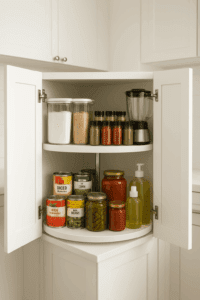The lazy Susan cabinet – that unique corner storage solution found in many kitchens – can either be your best friend or your biggest frustration. If you’ve ever found yourself wondering what do you put in a lazy Susan cabinet to maximize its potential, you’re not alone. These rotating storage systems offer incredible capacity but require strategic planning to avoid becoming a black hole where items disappear forever.
Understanding Your Lazy Susan Cabinet’s Potential
Before diving into what to store in your lazy Susan cabinet, it’s important to understand why these cabinets exist. Corner cabinets traditionally create dead space that’s difficult to access. The rotating mechanism of a lazy Susan transforms this awkward area into accessible storage, but only when used correctly.
The key to lazy Susan success lies in understanding that not everything belongs on the rotating shelves. The items you choose should be things you access regularly, store safely on a moving surface, and can easily identify from multiple angles as the shelves rotate.
Best Items for Lazy Susan Cabinet Storage
Canned Goods and Jarred Items
Canned goods are perfect lazy Susan residents. Their uniform shape stacks well, they’re stable during rotation, and you can easily see what you have at a glance. Organize them by type – all tomato products together, beans in one section, soups in another. The rotating action makes it simple to grab what you need from the back without moving everything in front.
Jarred items like pasta sauce, pickles, and condiments also work well. Their weight gives them stability during rotation, and the clear jars make identification easy. Group similar items together and consider using small bins or dividers to prevent rolling during cabinet movement.
Baking Supplies and Dry Goods
Your lazy Susan cabinet excels at storing baking essentials. Flour, sugar, baking powder, vanilla extract, and other frequently used baking supplies are perfect candidates. Use airtight containers to keep ingredients fresh and prevent spills during rotation. Clear containers work best because you can quickly identify contents and check quantities.
Spices and seasonings deserve special mention here. While a spice rack might seem like the obvious choice, a well-organized lazy Susan can hold far more varieties while keeping everything visible and accessible. Use uniform containers or a tiered spice rack system designed for rotating cabinets.
Small Kitchen Appliances
Counter space is precious, making your lazy Susan cabinet an excellent storage spot for small appliances you use regularly but not daily. Stand mixers, food processors, coffee makers, and blenders can find a home here. The rotating mechanism means you can position the appliance optimally for easy removal without wrestling with cabinet depth.
Just remember to check clearance – both height and the appliance’s cord length. You don’t want to discover your mixer doesn’t fit after you’ve reorganized everything else.
Cleaning Supplies (Kitchen-Safe Only)
Kitchen-specific cleaning supplies work well in lazy Susan cabinets. Dish soap, dishwasher detergent, surface cleaners, and paper towels are all good candidates. The rotating mechanism makes it easy to grab what you need quickly during cooking cleanup.
However, avoid storing harsh chemicals or anything that could contaminate food if it spills. Stick to food-safe cleaning products and always ensure containers are tightly sealed.
What NOT to Put in Your Lazy Susan Cabinet
Fragile or Breakable Items
The rotating motion of lazy Susan cabinets creates movement that can cause fragile items to shift, fall, or break. Fine china, glassware, and delicate serving pieces should find storage elsewhere. The constant motion, even when gentle, poses too much risk for valuable or irreplaceable items.
Items with Lids That Can Come Loose
Anything with a poorly fitting lid or cap should stay out of your lazy Susan. The rotation can cause loose lids to shift, potentially creating spills or making items difficult to access. If you must store items with lids, ensure they’re tightly secured or consider transferring contents to more secure containers.
Very Light Items That Slide Around
Empty containers, lightweight plastic items, and anything that tends to slide should avoid the lazy Susan treatment. These items will constantly shift position during rotation, making them difficult to locate and potentially causing avalanches when you try to remove something else.
Rarely Used Items
The lazy Susan’s superpower is accessibility, so don’t waste this prime real estate on items you use once a year. Holiday serving pieces, specialized gadgets for occasional use, and seasonal items should be stored in less accessible but more stable locations.
Maximizing Your Lazy Susan Organization
Choose the Right Storage Solutions
The difference between a functional lazy Susan cabinet and a chaotic mess often comes down to the right storage accessories. A quality lazy Susan turntable like this highly-rated option can transform your cabinet’s functionality. These aftermarket solutions often work better than built-in systems, offering smoother rotation and better weight distribution.
Consider adding dividers, small bins, and uniform containers to keep like items together. Stackable, clear containers work exceptionally well because they maximize vertical space while maintaining visibility.
Implement the “Heavy to Light” Strategy
Place heavier items toward the center and lighter items toward the outer edge. This distribution creates better balance during rotation and prevents the turntable from becoming top-heavy or wobbling during use. Heavy canned goods and appliances should occupy the inner positions, while spices and lighter items can sit along the perimeter.
Use Vertical Space Wisely
Don’t just think horizontally – lazy Susan cabinets often have significant vertical space that goes unused. Two-tier lazy Susans or stackable shelving systems can dramatically increase your storage capacity. Just ensure that upper levels remain easily accessible and don’t require dangerous reaching or stretching.
Create Zones for Different Categories
Establish specific areas for different types of items. Designate one section for baking supplies, another for canned goods, and a third for small appliances. This zoning system makes finding items intuitive and helps maintain organization over time.
Creative Lazy Susan Solutions
The Breakfast Station
Transform part of your lazy Susan into a breakfast command center. Coffee, tea, cereal, oatmeal, honey, and breakfast condiments can all rotate together, making morning routines smoother. Add a small bin for coffee filters and tea bags to keep everything contained.
Snack Central
Create a rotating snack station that’s perfect for families. Crackers, nuts, dried fruits, and other shelf-stable snacks can occupy one section, making it easy for family members to find something to eat without rummaging through multiple cabinets.
International Cuisine Corner
If you love cooking diverse cuisines, dedicate lazy Susan space to international ingredients. Asian sauces and seasonings in one section, Mexican spices and canned goods in another, and Mediterranean items in a third. The rotating mechanism makes it easy to find exactly what you need for any recipe.
Beverage Station
For those who entertain frequently, consider creating a non-alcoholic beverage station. Coffee, tea, hot chocolate, drink mixes, and accompaniments like sugar and creamer can all live together on your lazy Susan, making guest service effortless.
Maintenance and Safety Tips
Regular Cleaning and Maintenance
Lazy Susan mechanisms require occasional cleaning and lubrication to function smoothly. Remove all items periodically to clean the turntable surface and check the rotating mechanism. A drop of food-safe lubricant on the bearing can prevent squeaking and ensure smooth operation.
Weight Distribution Awareness
Be mindful of weight limits and distribution. Most residential lazy Susan systems can handle substantial weight, but uneven loading can cause binding or damage. Spread weight evenly and avoid overloading any single section.
Check Clearances Regularly
As you add and remove items, double-check that nothing interferes with the rotation. Items that are too tall or extend beyond the cabinet opening can jam the mechanism or damage cabinet doors.
Safety First with Chemicals
If you choose to store any cleaning products in your lazy Susan cabinet, ensure they’re kitchen-appropriate and won’t contaminate food if they spill. Keep them in a separate section from food items and always ensure containers are tightly sealed.
Troubleshooting Common Lazy Susan Problems
Items Keep Falling Over
This usually indicates that items are too light, too tall, or improperly positioned. Try using small bins to contain lightweight items, or relocate unstable items to traditional cabinets. Adding a small lip or rail around the edge can also help prevent items from sliding off during rotation.
Can’t Find Things Despite Organization
If items keep “disappearing” in your lazy Susan, you may be storing too much or not grouping items logically. Reduce the quantity of stored items and ensure that similar items are grouped together in easily identifiable sections.
Rotation Feels Sticky or Difficult
This typically indicates that the mechanism needs cleaning or lubrication, or that items are catching on the cabinet structure. Remove everything, clean the mechanism, and check for any items that might be extending beyond safe boundaries.
Cabinet Doors Hit Items During Rotation
This clearance issue requires repositioning items away from the door swing area or choosing lower-profile storage solutions. Sometimes, adjusting the lazy Susan’s position within the cabinet can resolve clearance problems.
Budget-Friendly Organization Ideas
DIY Container Solutions
Before investing in expensive organizers, try repurposing containers you already have. Shoe boxes, food containers, and small bins can be excellent lazy Susan organizers when labeled clearly. Just ensure they’re food-safe if storing edibles.
Gradual Upgrades
You don’t need to organize your entire lazy Susan cabinet at once. Start with one category of items, perfect that system, then gradually expand. This approach spreads costs over time and lets you learn what works best in your specific space.
Multi-Purpose Items
Look for storage solutions that serve double duty. A lazy Susan turntable that also has raised edges can prevent spills while organizing. Stackable bins with handles make it easy to remove entire categories of items when needed.
Seasonal Considerations
Holiday Preparation
During baking-heavy seasons like holidays, temporarily reorganize your lazy Susan to prioritize baking supplies. Move less frequently used items to other storage areas to make room for extra flour, sugar, spices, and seasonal ingredients.
Summer Entertainment
If you entertain more during summer months, shift your lazy Susan organization toward items that support outdoor cooking and entertaining. Condiments, marinades, and grilling accessories might take priority over winter comfort food ingredients.
Back-to-School Organization
Families might reorganize lazy Susan contents to support packed lunches and quick breakfast preparation during the school year. Easy-to-grab snacks, lunch-making supplies, and breakfast items become priorities.
Understanding what do you put in a lazy Susan cabinet comes down to matching the right items to this unique storage system’s strengths. When used strategically, your lazy Susan cabinet becomes one of your kitchen’s most valuable storage assets, providing easy access to frequently used items while maximizing corner space that would otherwise go to waste.
The key is being selective about what you store, organizing thoughtfully, and maintaining the system regularly. With the right approach and perhaps a quality turntable upgrade, your lazy Susan cabinet will transform from a source of frustration into a model of kitchen efficiency.
This article contains affiliate links, which means we may earn a small commission at no extra cost to you if you click through and make a purchase.


